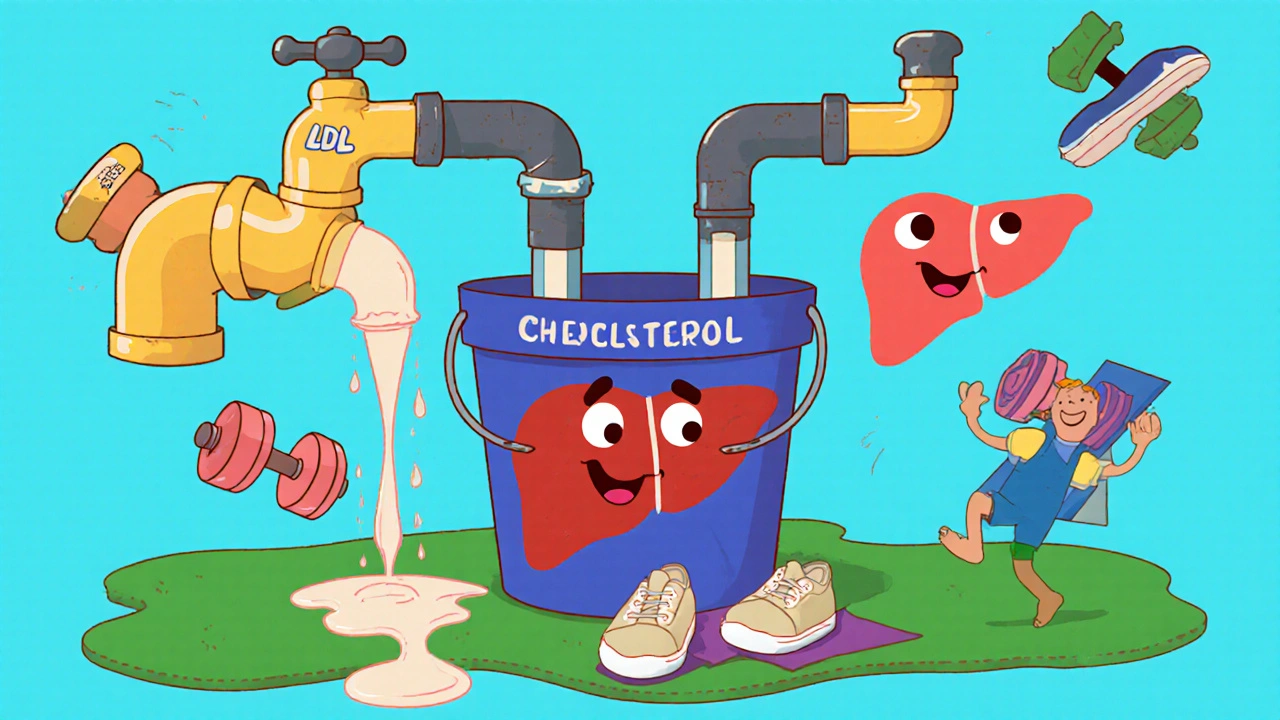High cholesterol doesn’t just show up on a lab report-it creeps into your arteries, slows your blood flow, and silently raises your risk of a heart attack. If you’ve been prescribed ezetimibe, you’re not alone. Millions of people take it to lower LDL, the "bad" cholesterol, especially when statins alone aren’t enough. But here’s the thing most people miss: ezetimibe doesn’t work in isolation. When paired with regular exercise, its effects don’t just add up-they multiply.
What Ezetimibe Actually Does
Ezetimibe isn’t a statin. It doesn’t block cholesterol production in the liver. Instead, it works in your small intestine. It stops your body from absorbing dietary cholesterol and reabsorbing bile-derived cholesterol that’s meant to be flushed out. Think of it like a bouncer at the gut’s entrance-only letting in what your body truly needs.
Studies show ezetimibe lowers LDL cholesterol by about 15-20% on its own. That’s not huge compared to high-dose statins, but when combined with them, it pushes LDL down another 20-25%. In the IMPROVE-IT trial, patients on ezetimibe plus simvastatin had 6.4% fewer heart attacks and strokes over seven years than those on statin alone. That’s not a miracle-but it’s meaningful, especially for people with diabetes, prior heart events, or genetic cholesterol disorders like familial hypercholesterolemia.
Why Exercise Isn’t Just "Good for You"-It’s a Medication
Exercise isn’t a suggestion. It’s a treatment. When you move-whether it’s brisk walking, cycling, or strength training-you trigger biological changes that drugs alone can’t replicate.
Regular physical activity raises HDL (the "good" cholesterol), lowers triglycerides, reduces inflammation, improves insulin sensitivity, and even helps your arteries stay flexible. But here’s the kicker: exercise also changes how your body handles cholesterol. It increases the number of LDL receptors in your liver, which means more bad cholesterol gets pulled out of your bloodstream. That’s the same mechanism statins use-but exercise does it naturally, without side effects.
And it doesn’t take much. A 2023 meta-analysis in the Journal of the American Heart Association found that 150 minutes of moderate aerobic activity per week (about 30 minutes, five days a week) reduced LDL by 5-10% and triglycerides by 15-20%. Add resistance training twice a week, and those numbers climb higher.
How Ezetimibe and Exercise Work Together
Imagine your body’s cholesterol system as a leaky bucket. Ezetimibe turns off the tap-reducing how much cholesterol flows in from food and bile. Exercise opens the drain-helping your liver pull more cholesterol out of your blood. Together, they’re not just complementary. They’re synergistic.
One small but telling study from the University of Birmingham tracked 82 adults with high LDL on ezetimibe. Half added 150 minutes of walking or cycling weekly. After six months, the group that exercised saw an extra 12% drop in LDL compared to those who only took the pill. Their triglycerides fell by 18%, and their HDL rose by 8%. Their blood pressure also dropped slightly-not because of the drug, but because of movement.
Exercise also helps with adherence. People who move regularly are more likely to stick with their meds. Why? Because they start feeling better. Energy improves. Breathing gets easier. Morning stiffness fades. That momentum turns medication from a chore into part of a healthier lifestyle.
What Kind of Exercise Works Best?
You don’t need to run marathons. You don’t need a gym membership. You need consistency.
- Aerobic exercise: Brisk walking, swimming, cycling, dancing. Aim for 30 minutes, five days a week. If that’s too much, break it into 10-minute chunks. Three 10-minute walks still count.
- Resistance training: Bodyweight squats, push-ups, dumbbells, resistance bands. Two days a week. Focus on major muscle groups-legs, back, chest, core. Muscle burns more calories at rest, which helps your body clear cholesterol faster.
- Flexibility and balance: Yoga or tai chi. These aren’t just for relaxation-they reduce stress hormones like cortisol, which can raise LDL over time.
Start slow. If you’re new to exercise, begin with 10 minutes a day. Walk around your block. Take the stairs. Park farther away. Build up over weeks, not days. The goal isn’t intensity-it’s habit.
What to Avoid
Not all movement helps. High-intensity interval training (HIIT) can be great-but if you’re just starting out, have heart disease, or are over 65, jump into sprints too fast and you risk injury or strain. Same with heavy weightlifting without form coaching. Your heart is working harder. Don’t push it into danger.
Also, don’t assume exercise cancels out bad habits. Eating fried food every day while jogging won’t fix your cholesterol. Ezetimibe helps, but it’s not a magic shield. Reduce trans fats, limit added sugars, and eat more fiber-oats, beans, apples, flaxseeds. Fiber binds cholesterol in your gut and helps flush it out. It works like ezetimibe’s sidekick.

Real People, Real Results
Take Sarah, 58, from Solihull. She was on ezetimibe after a mild heart attack. Her LDL hovered around 130. She hated the gym. So she started walking her dog every morning-30 minutes, rain or shine. Six months later, her LDL dropped to 88. Her doctor was surprised. She wasn’t taking more pills. She was just moving.
Or James, 62, with familial hypercholesterolemia. His LDL was 210 despite statins and ezetimibe. He added two 45-minute bike rides a week and two sessions of light weight training. In a year, his LDL fell to 110. He stopped feeling winded climbing stairs. He slept better. He felt like himself again.
These aren’t outliers. They’re the rule when medication meets movement.
When to Talk to Your Doctor
Before starting any new exercise plan, especially if you have heart disease, diabetes, high blood pressure, or joint problems, check with your GP or cardiologist. They might recommend a stress test or refer you to cardiac rehab-a program designed to help people like you move safely and effectively.
Also, don’t stop your meds because you feel better. Ezetimibe works best when taken daily. Skipping doses can undo progress. And don’t assume exercise lets you eat whatever you want. You’re still managing a chronic condition. Lifestyle changes support the drug-not replace it.
Bottom Line: The Real Power Pair
Ezetimibe isn’t a quick fix. Exercise isn’t a trend. Together, they’re a proven, low-cost, side-effect-light strategy to protect your heart for decades. You don’t need to run a marathon. You don’t need to lift heavy. You just need to move-regularly, consistently, and without guilt.
Your arteries don’t care how hard you work out. They care that you showed up. Again. And again. And again.
Can I take ezetimibe without exercising?
Yes, ezetimibe works on its own to lower LDL cholesterol by blocking intestinal absorption. But studies show that combining it with regular physical activity leads to significantly greater improvements in cholesterol levels, inflammation, and overall heart health. Exercise enhances how your body clears cholesterol and improves blood vessel function-effects the drug alone can’t fully deliver.
Does exercise lower LDL as much as ezetimibe?
Exercise alone typically lowers LDL by 5-10%, while ezetimibe lowers it by 15-20%. So ezetimibe has a stronger direct effect. But exercise also raises HDL and lowers triglycerides-things ezetimibe doesn’t do much for. Together, they cover more ground than either does alone.
What’s the best time of day to exercise when taking ezetimibe?
There’s no evidence that timing matters for ezetimibe. It’s taken once daily, with or without food. The best time to exercise is whenever you’ll stick with it. Morning walks can boost energy and set a healthy tone for the day. Evening workouts help reduce stress. Pick what fits your routine.
Can I stop ezetimibe if I start exercising regularly?
No. Ezetimibe is prescribed because your body has trouble managing cholesterol naturally. Exercise helps, but it doesn’t replace the drug’s mechanism. Stopping your medication without medical advice can cause your LDL to rise again, increasing heart risk. Always talk to your doctor before making changes to your treatment plan.
Are there side effects of combining ezetimibe and exercise?
Ezetimibe is generally well-tolerated. Common side effects include mild stomach upset or fatigue-rarely serious. Exercise, when done safely, has no negative interaction with ezetimibe. In fact, it often reduces side effects like muscle soreness linked to statins. Always listen to your body. If you feel dizzy, chest pain, or extreme shortness of breath during exercise, stop and seek medical advice.




